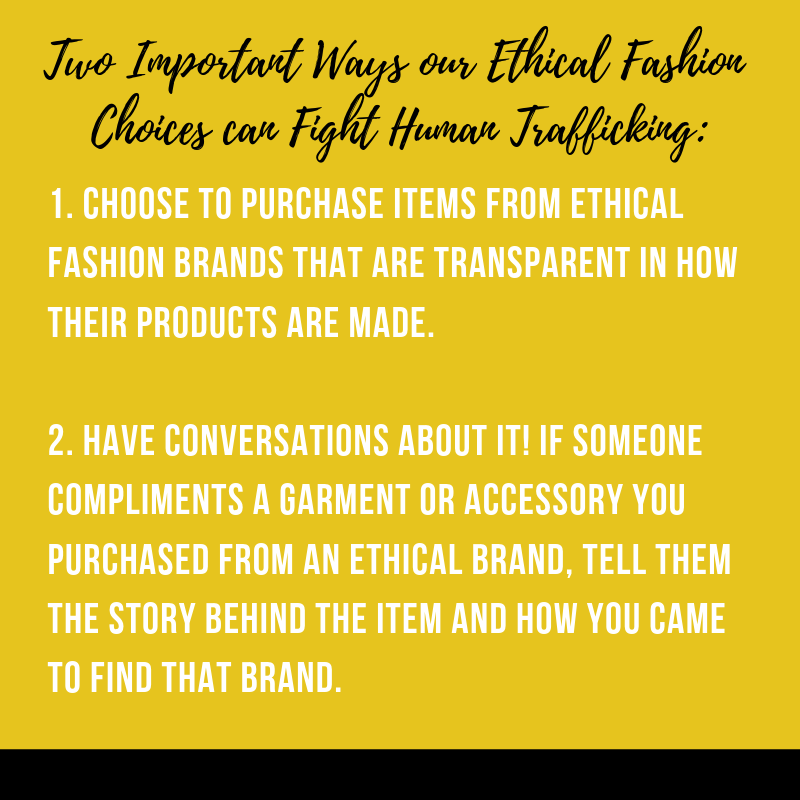How does ethical fashion play into human trafficking?
Can you relate to the thrill of seeing a cute item of clothing, then checking the price tag and thinking, “How can I NOT get this? It’s only $10!” Or having a friend compliment your outfit and then squeal over how cheap it was?
I certainly find a thrill in doing some retail therapy that doesn’t hurt my wallet. However, what often goes unnoticed is the exploitative process of making that cheap piece of clothing.
Fast fashion describes the rapid movement of inexpensive garments from the runway to the store in order to keep up with trends. It stocks stores with beautiful, on-trend items that are hard to say “no” to because of their low prices. But would we consider thinking twice before buying if we knew how that garment was made? If we were to meet the man or woman who made that article of clothing, talked to them about their salary or working conditions, and put ourselves in their shoes - would the $10 skirt be worth it?
Photo Credit: World Vision International
“The International Labor Organization (ILO)...estimates that there are 170 million children engaged in child labor, many of whom are working in textile factories. ”
What is really behind fast fashion?
In the words of Dressember Founder and CEO, Blythe Hill, “If it seems too good to be true, it probably is.”
The ILO identifies forced labor as “work that is performed involuntarily and under the menace of any penalty.” In many developing countries, workers are brought into garment factory jobs under false promises of fair wages, then end up working under the definition of forced labor. The ILO also estimates that there are 170 million children engaged in child labor, many of whom are working in textile factories.
So, how exactly does fashion contribute to human trafficking?
Fast fashion has pushed companies into a “race to the bottom” where they seek out the cheapest way to keep up with the rising demand for fashion. Unfortunately, this demand trickles down the supply chain causing harsh working conditions for workers, many of whom have been trafficked into their position. As companies chase cheaper labor and production, the textile industry falls into a trend of cutting corners and ignoring safety measures to keep production costs low.
“3 out of 4 of the worst tragedies in the history of fashion occurred between 2013-2014.”
This vicious cycle of cheap production eventually led to a breaking point that shocked the world. On April 24, 2013, the Rana Plaza factory in Bangladesh collapsed, killing 1,138 and injuring 2,500 after factory owners ignored an order to evacuate due to structural instability of the building. The tragedy at Rana Plaza was not an anomaly, as news of disaster after disaster in garment factories continue to fill the news. According to a documentary on fast fashion, The True Cost, 3 out of 4 of the worst tragedies in the history of fashion occurred between 2013-2014. Ultimately, garment workers are paying the price for cheap clothing.
It is easy to look at these problems and feel helpless when we live in a time bombarded with advertisements for new trends coming out every few weeks. I walk past these “fast fashion” stores almost every day and have a hard time not staring longingly at the window display. But this is where we, as Dressember advocates and seekers of justice, can use the power of our voices and our purchases. We have the right to know how our garments are produced.
When we dig deeper into the production of the things we buy, we can avoid supporting companies that are perpetuating fast fashion, human trafficking, and environmental degradation. Ethical fashion brands are often extremely open with their methods of production. Whenever you go to a store or a website in search of a piece of clothing or accessory, try doing some research on where and how their products were made.
Our everyday choices are making a difference in the world, even when it doesn’t feel that way. When we choose to hold off on buying a $10 dress from one store and decide to save up for a fairly made $60 dress, we are sending the fashion industry a powerful message. As Dressember advocates, we can shed an honest light on fashion and ask the golden question coined by Fashion Revolution: “Who made my clothes?”
If you’re new to the idea of ethical fashion, we want to help make the transition as easy as possible. Check out our list of brand partners for great ethical options, and stay updated every Friday to the Dressember blog where we share ethical fashion tips and companies doing incredible work!
It is not too late to be a part of the impact!
Right now, thousands of people around the world are taking on the creative challenge of wearing a dress or tie in the month of December. The reason? To bring freedom to the 40+ million around the world still trapped in slavery. Your donation or participation in Dressember 2018 is part of a movement to end human trafficking for good.
About the Author
Anna Stephens is a native Texan pursuing her Master's of Environmental Studies and Sustainability Science at Lund University in Sweden. She has participated in Dressember for three years, and plans to continue using fashion as a platform for awareness and eradication of human trafficking. In her spare time, you can find her drinking iced coffee, looking for dogs to pet, or exploring Swedish nature with her friends.







